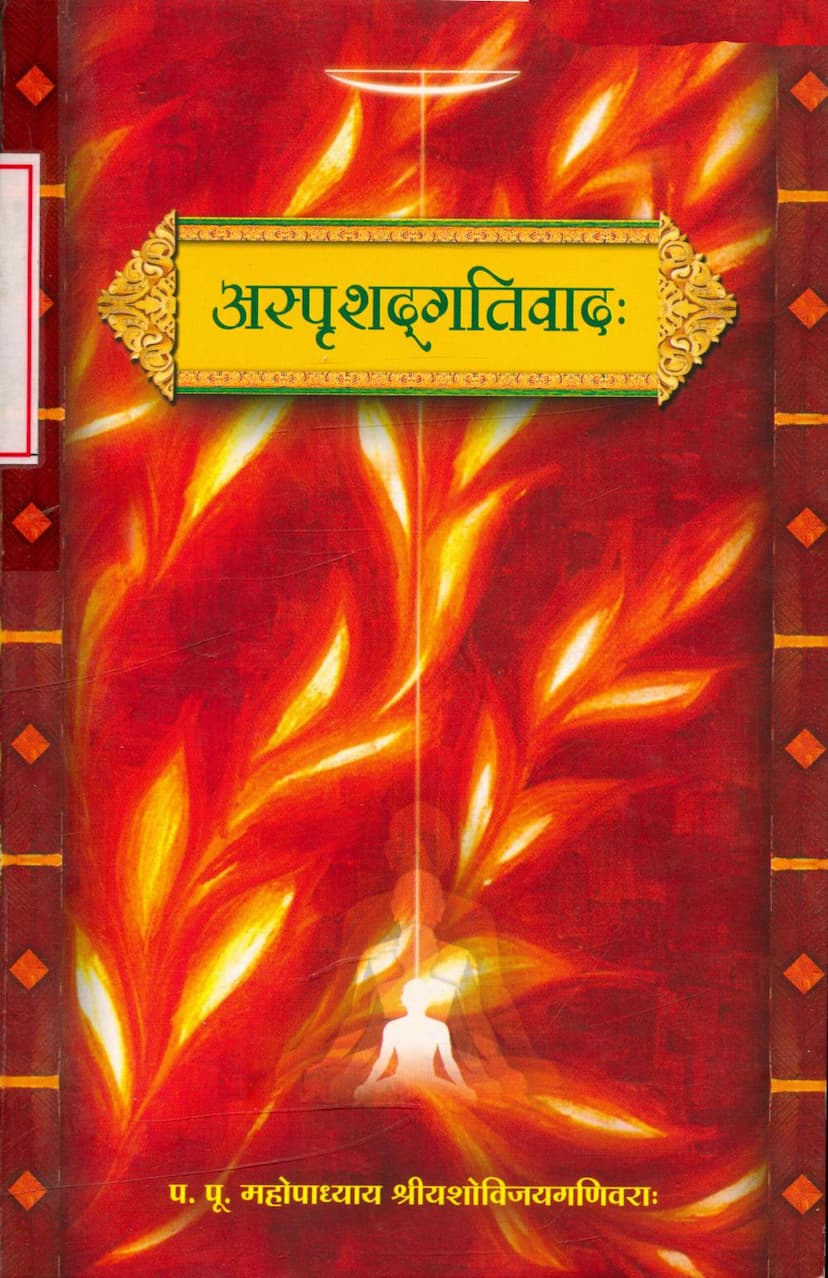Asprushad Gatiwad
Added to library: September 1, 2025

Summary
Here's a comprehensive summary of the Jain text "Asprushad Gatiwad" by Yashovijay Gani, based on the provided pages:
Book Title: Asprushad Gatiwad (Meaning: Theory of Untouching Motion) Author: Mahopadhyaya Shri Yashovijay Gani Publisher: Shri Jinshasan Aradhana Trust Catalog Link: https://jainqq.org/explore/022475/1
Core Subject:
The book delves into a profound philosophical concept within Jainism: Asprushad Gati (untouching motion). This refers to the motion of a soul (Jiva) when it achieves liberation (Siddhi). Specifically, it addresses the seemingly paradoxical phenomenon of a soul reaching the ultimate boundaries of the universe (Lokanta) in a single moment without traversing and touching the intervening infinite spatial units (Akasha Pradesh).
Key Philosophical Problem Addressed:
The central debate revolves around the nature of space and motion. Since Akash Pradesh are considered all-pervading and any motion is generally understood to involve traversing through spatial units, the question arises: How can a soul move across vast distances instantaneously without touching any intervening space? If it touches each space unit sequentially, it would take an immeasurable amount of time, contradicting the scriptural assertion of instantaneous liberation.
The Author's Stance and Argument:
- Mahopadhyaya Yashovijay Gani, a renowned Jain philosopher and logician, presents a detailed and nuanced argument in favor of Asprushad Gati. He uses rigorous logic, scriptural references (Agamas), and refutations of counter-arguments (Purvapaksha) to establish his thesis.
- He explains that Asprushad Gati is called "untouching" because the liberated soul does not touch the intermediate Akash Pradesh during its instantaneous journey to the Siddhashila (the abode of liberated souls).
- The book counters the common-sense intuition that motion must involve touching space. It argues that the soul's movement is not bound by the same physical laws as worldly motion.
- Yashovijay Gani meticulously analyzes and refutes various objections and alternative interpretations, such as:
- The idea that touching higher Akash Pradesh necessarily implies touching lower ones.
- The concept of "Dand Karan" (stick-like extension) as proposed by some, which might allow for instantaneous reach but not necessarily the specific nature of liberated motion.
- The interpretation of "untouching" as merely avoiding touching the sides of the spatial units, rather than the entire intervening space.
Methodology and Presentation:
- The original text is presented in Sanskrit, with a contemporary Gujarati commentary (Vritti) titled "Asarshopanishad."
- The commentary and editing are done by Acharya Vijay Kalyanbodhisurishwarji, a disciple of Acharya Vijay Hemchandrasurishwarji.
- The author extensively quotes and refers to other important Jain scriptures like the Prajnapana Sutra, Aavashyak Churni, and commentaries by Acharya Malaygiri, demonstrating a deep understanding of the Jain canon.
- The book engages in detailed dialectical arguments, presenting hypothetical objections and then systematically dismantling them with logical reasoning and scriptural authority.
- The text emphasizes that the instantaneous, untouching nature of the soul's movement to liberation is not a violation of logic but a subtle truth understood through advanced philosophical reasoning and ultimately realized through perfect knowledge (Kevali Gamyam).
Key Supporting Arguments from the Text:
- Reference to scriptures: The book highlights scriptural passages that explicitly mention the instantaneous and non-touching nature of the liberated soul's movement.
- Analogies: While not explicitly detailed in the provided excerpts for summary, the text implies the use of analogies to explain the non-intuitive concepts, often contrasting them with everyday experiences to highlight the difference.
- The role of "Shakti" (Power): The author argues that the instantaneous and non-touching motion is made possible by the soul's inherent, extraordinary power (Achintya Shakti) which transcends ordinary physical limitations. This power is what allows the soul to overcome the perceived necessity of touching intervening space.
- Distinction between various types of "untouching": The text clarifies that "untouching" can be relative (e.g., not touching certain adjacent elements) or absolute (not touching any intervening elements). The motion of a liberated soul is of the latter, absolute kind in relation to the intermediate space.
- Refutation of "Dand Karan": The book argues that while "Dand Karan" might explain rapid movement, it doesn't fully account for the specific nature of liberated motion described in the scriptures.
- The concept of "Rijushreni": The straight path (Rijushreni) taken by the liberated soul is emphasized, implying a direct, unbent movement that bypasses intermediate interactions.
Significance:
- "Asprushad Gatiwad" is presented as a unique and highly specialized work, possibly the only independent treatise on this complex topic.
- It aims to resolve doubts and clarify the subtle philosophical implications of the Jain doctrine of liberation.
- The book is intended for learned individuals (Gitaarth Guru, Anugnyat Aatma) who are capable of engaging with such profound and intricate philosophical arguments.
Overall Purpose:
The book serves as a scholarly defense and elucidation of the Jain concept of Asprushad Gati, demonstrating how the seemingly impossible feat of instantaneous, non-touching movement to liberation is logically and scripturally consistent within the Jain philosophical framework. It showcases the analytical prowess of Mahopadhyaya Yashovijay Gani in tackling such challenging metaphysical questions.